
While researching for my new book Viral Art, I conducted about 50 interviews with artists, curators, photographers and writers. Most were done in person or over Skype, but a handful were conducted via email. Only a handful of what came out in those interviews made it into the book, so now I want to publish a few of those email interviews in full here on Vandalog. In these extended interviews, you can probably see even more clearly than in Viral Art how I unashamedly ask leading questions, and the topics jump around a lot, but hopefully they are still interesting.
To start, we have C215. An abridged version of this interview appears in Viral Art. C215 was one of the street artists that first attracted me to the genre. His stencils peppered the streets of London right as I was discovering street art, and each one blew me away. His trademark style is hard to top for beauty and for capturing great details in just one or two layers.
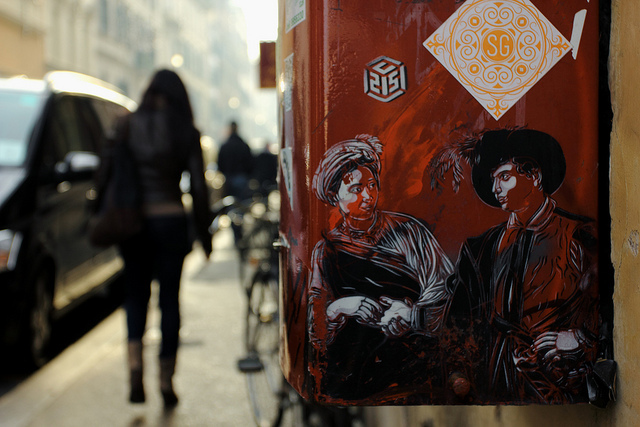
RJ: How do you define street art?
C215: Street art is nothing else but urban poetry that catches someone’s eye. Being a street artist is impossible, because the city itself is the artist. Street art is a collective thing, participative and interactive, extremely linked to web 2.0 culture.
RJ: What was the Underbelly Paris like? How do you describe the Underbelly Project?
C215: For my part, it was an incredible time spent with very good friends. My vision is romantic. I had a nice time with some people Iove, others that I met and then admired after working with them. It was a beautiful collective project, led by beautiful artists.
RJ: Is it important to continue the tradition of illegal graffiti and street art?
C215: Graffiti consists in leaving tracks behind you, street art consists in placing art in the streets. You can do it with authorization, but the poetry of it would not be the same. There is something poetic in taking legal risk just to make your city more beautiful.
RJ: How did you start making art and how did your distinctive style develop?
C215: I began to paint when kid, but my style went strong the night I lost my grandmother. She was everything for me and supported me until her end. For a long time, I have had a borderline personality disorder, and when she disappeared my personality collapsed overnight. I was just lost, not knowing anymore who or where I was. I spent the night cutting a stencil of a homeless person’s face, to express my feelings. I cut it so detailed and with so many bridges that he looked crackled. This became my style for while. This style is now credited to me and imitated around the world, but comes from my self expression and from a very personal story.

RJ: Do you find it difficult to adapt your outdoor techniques to indoors? How did you go about it?
C215: I work indoors as little as possible, since I think my work is made for outdoors. I do not use stencils for doing patterns. I do not repeat images. I use them to go smaller than a spraycan cap, so to get details, and to create a proper artwork anywhere, very quick and without authorization. Galleries are white spaces that I find boring to paint in. It’s not new to paint on a white wall. What is new is to paint a nice work somewhere illegally, and spread it immediately to the whole world through internet.
RJ: How long do your pieces usually last on the street?
C215: Depends on the piece. You never know in advance. Some stay for years, others disappear immediately. A piece could be dissed, buffed, destroyed, covered or stolen… The piece will evolve and age anyway. That is why we call it street art. You allow things to be out of your control. The art you leave behind is alive, so ephemeral, contrary to the collectible pieces that are kept like dead mummies.
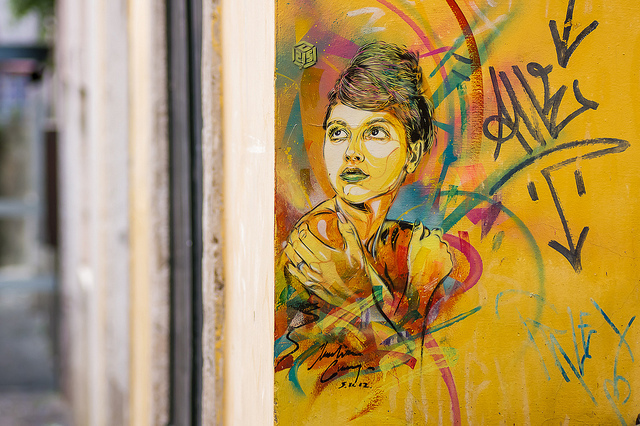
RJ: How do you find source material for your stencils?
C215: Anywhere on the web if I need a picture for the streets, but for my gallery works, since my works recently became valuable, I pay attention to using pictures of mine or pictures I got the rights to use.
RJ: What do you mean when you say that street art is “extremely linked to 2.0 culture”? Can you expand on that thought? How is it linked?
C215: Like the streets, the internet is not considered by most as venue for art. It is simultaneously an interactive and participative place, as streets can be. You go into the streets, leave something that you paint, that you sampled from reality through a photograph. It creates a real installation. Then street photographers will pass by and take a picture of your installation and put it immediately onto web, spreading it online. You can then see how your work has been altered by the photographer, putting a new spin on it. Some of them get real artistic pictures that just include a piece of yours. This is the process of street art.
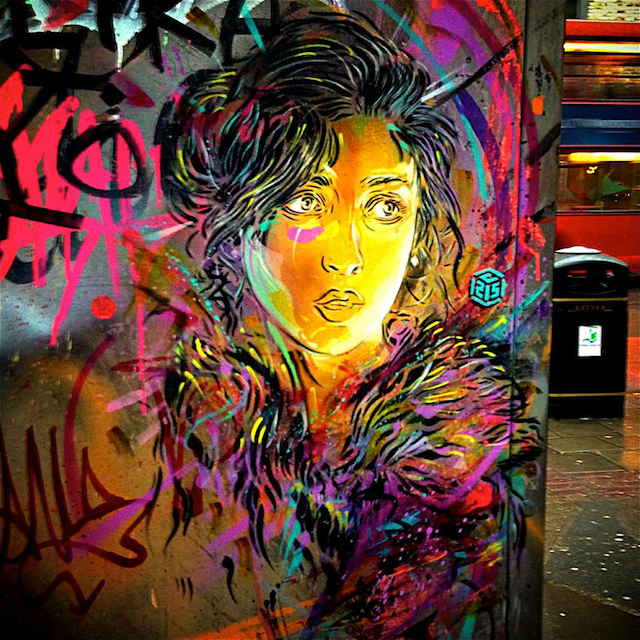
RJ: Do you always document your work and share it on the internet?
C215: Yes, since whatever I paint is ephemeral, I keep pictures and publish them. It is a kind of diary, since I travel a lot to experience new contexts.
RJ: You make it sound as though taking photos and posting them online is nearly as important a part of your artistic process as cutting and spraying the stencils. Is that the case? If so, why?
C215: This is the only new thing: Painters have been painting since forever, doing murals since antiquity, using spray cans for a long time now. So what is new if not the internet thing? On the internet you are your own gallerist, theoretician, photographer and videomaker. On the internet you can interact with your public without being physically present, as it should be with graffiti. If we are contemporary artists, it is because we use the internet.
RJ: With this question, I’m thinking in particular about painting in abandoned places like The Underbelly Project. How is it different when work is painted in an inaccessible place and has to be documented to be seen by the general public compared to when you paint where people are likely to see the stencils in person? Is that still public art or street art as you define it?
C215: We can not call street art something that happens somewhere other than in the street. Urban art would be better. Viewers want to go and see to get proof that the art is real. Every week someone comes to me to ask how he can find the tunnel by himself.
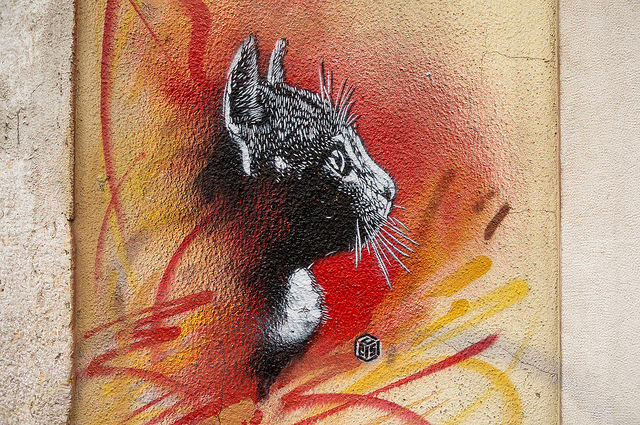
RJ: Do you think that being in Paris led you to working with stencils?
C215: Sure! Paris has such a long history with street art and that is mainly through stencils that appeared in the 80’s. Apparently more than 120 stencil artists were already painting in the streets of Paris in the mid-80’s. I feel that I am just one of the numerous french stencil artists, and I am proud to get credit in such a competition.
RJ: Do you prefer to look at your street art in person or through photographs?
C215: I prefer to see work other than mine! It depends on the scale. Very small and very big pieces have to be seen with pictures. I think my art is interesting enough in both cases. But I am not good at going big, because I like paintings full of life, not static graphics.
RJ: Do you think Paris is particularly suited towards stencils more than other cities, or that the popularity of stencils in Paris is more about people being influenced by Blek le Rat and other early Parisian stencil artists?
C215: Blek does not have that much influence here. He has not been in the streets for almost a decade. In a certain way, he is an abstract reference. In the 80s there were a lot of artists, and miss tic, nemo (who certainly inspired banksy too) and jef aerosol have been far more influential than blek and others, because they have been very present in the streets.
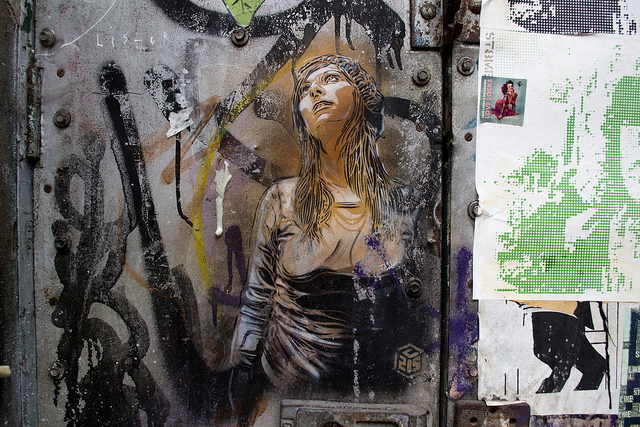
RJ: Do you think that street art is ideally free, ephemeral, accessible and illegal?
C215: Exactly. Can not be something else. You can add: collective, public, interactive, surprising, human, personal, poetic, visionary, revolutionary, etc.
RJ: How do you generate publicity for your projects and why do you use the strategy that you do?
C215: In the streets and on internet, because these places are the most beautiful galleries ever. We are now entering the “hypermediation” culture. No medias anymore, we need nobody and we do art where you not expect it, outside of anyone’s control. The streets and the internet are strongly linked to freedom.
RJ: How do you use your flickr?
C215: To keep safe from any possible physical destruction of the high resolution files of my street work. It is a chronological and geographical diary too.
RJ: Can you imagine making work with the intention that it would be primarily or entirely for a digital audience?
C215: No.
RJ: How did you generally meet other street artists?
C215: As few as possible!
RJ: How do most people see your work? Online or in person? If they see it online, how do they come across it?
C215: Physically for sure, and with no comparison, but in the streets people see mainly one artwork, not a whole body of work or the brand identification that you get on internet, where each artist more or less organizes his own virtual perception, while street works keep it real. It is a balanced story, between art and life, reality and abstraction.
RJ: At what point did you realize that the internet was making an impact in street art and graffiti?
C215: The day my 9 years daughter said to me that she read most of my past interviews using google on her iPod.
RJ: Since you see the internet as what makes your work a contemporary thing and that you say some works may be seen better through photography, why is it important for you to make physical works that will be seen in person?
C215: Because I am not a graphic designer. My art corresponds to my life, and I like to cut stencils and do graffiti. These marks are proofs of my passing by. For those who want to feel my works, it has to be seen once in the streets. Then you can begin your complementary research and understand the whole thing on internet. I can not imagine these two parts separately.
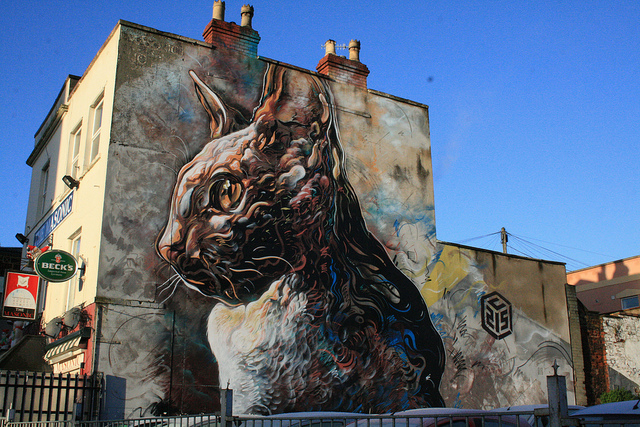
Photos by r2hox, _Pek_, RJ Rushmore and MsSaraKelly
